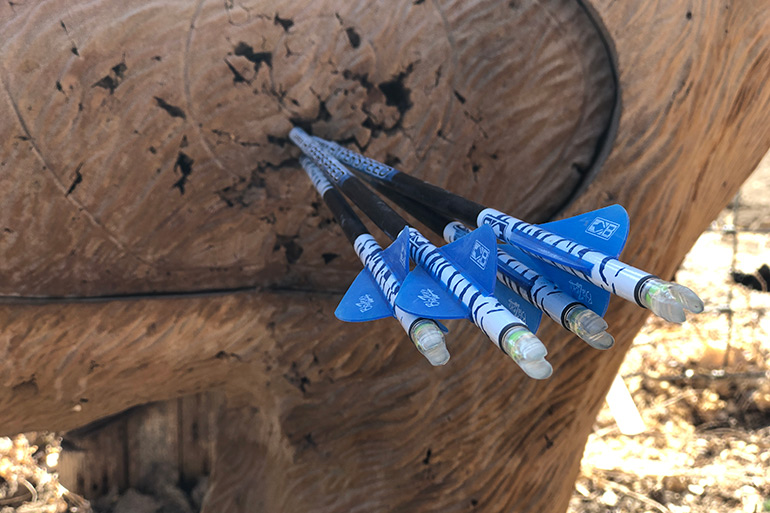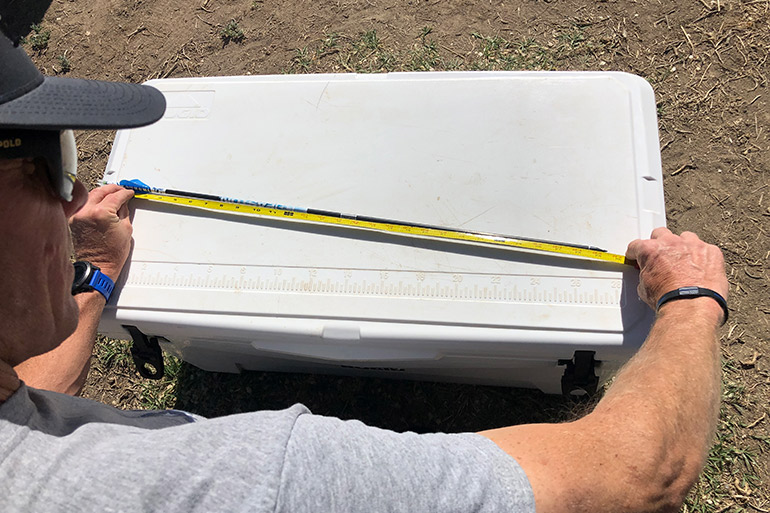
For top-notch accuracy and the best penetration you can get, your FOC — or front-of-center — has to be properly calculated.
If you’ve been involved in the sport of archery for any amount of time, you’ve likely heard someone toss around the abbreviation FOC But what is it, really? Why do you need to know? How can it positively or negatively impact your accuracy and overall arrow performance? Let’s dive in.
FOC stands for front-of-center. In laymen’s terms, it’s the percentage of the arrow’s total weight that resides in the front half. While some claim FOC only matters to those shooting for big checks in 3-D tournaments and FITA Archery events where shots tend to be long and the competition fierce, I disagree. A perfect FOC percentage will boost arrow performance, which in turn boosts accuracy. In addition to improved accuracy, a solid F.O.C. percentage will help with penetration. With more of the arrow’s weight in the front half, the initial wallop is increased.
The trick is finding the right FOC percentage. Get too high of an FOC, and the weight in the arrow’s front end will quickly drag it down. You will lose speed, and because the arrow is shedding trajectory at a rapid rate, accuracy issues will occur. This is a big turnoff to many. Some shooters fear they will lose too much velocity and not be able to shoot as far. False. If FOC is calculated correctly, speed and trajectory loss are minimal. I will take a shaft that flies a little slower but shoots like a bullet and hits like a tank any day.
Shoot an arrow with too low of an FOC and erratic arrow flight will occur. The shaft will carry too much weight in the backend, which will cause serious left and right issues. Penetration issues will also arise. This is a big reason those who limit their bowhunting shots to 40 yards and under still need to care about FOC. The goal is always a pass-through, and a perfect FOC percentage will lead to more shots that cause blood to leak from both sides.
Your goal is to shoot an arrow with an FOC between 11 and 15 percent. This is ideal for hunting setups and will ensure pinpoint accuracy at longer distances. Am I suggesting taking shots on animals at longer distances just because you have spot-on FOC? Negative. However, I do recommend all archers practice regularly at a distance of 30 yards past where they feel comfortable shooting an animal. Why? Confidence. When you can drop a four-arrow group in the 10-ring of a Rinehart deer target at 70 yards, you get in a zone. Your confidence grows with each arrow, and when you step up to 40 yards, the distance looks and feels like 20.
If you never take time to find your FOC percentage, you’ll never be as accurate as you could be at long range. Your bow may be tuned. Your grip may be perfect. Your hold rock solid. If your FOC is too much or too little, you will struggle with accuracy at distance, which will lead to frustration and confidence issues.

Finding your FOC requires a little math, but a NASA-pedigree isn’t required. First, make sure your arrow is fitted with the nock, broadhead, vanes and insert you’ll be hunting with. If you find your FOC with a standard nock and then change to a lighted nock, your FOC will change. Lighted nocks are a tad heavier than standard nocks, which will add weight to the backend of your shaft. Also, don’t figure FOC with a 75- or 100-grain field point and then switch to a 125-grain broadhead for hunting.
Once you have a fully outfitted arrow, run a tape measure from the bottom of the nock groove to the end of the shaft and divide by two. Mark that spot on the shaft. Next, find the balance point of the arrow. I like to use a small bench or table for this. This is the point where the arrow will balance perfectly without tipping over the edge. Mark this point with a Sharpie. Now measure between the two marks on your shaft. Next, take the distance between the two marks and divide that number by the arrow’s total length. Lastly, multiply this number by 100 and you’re all set.
My particular math looks like this: From the nock groove to the end of my shaft is 29 inches. I divided that number by two to get 14.5. The distance between the 14.5 mark and the balance point mark equals 3.25 inches. Dividing 3.25 by 29 and then multiplying by 100 gives me an F.O.C. of 11.2 percent. After adding my brass weight, my overall F.O.C. is 12.5 percent.
You did the math, crunched the numbers and found your FOC didn’t fall into that 11 to 15 percent sweet spot. Buy new arrows? Sure, that’s an option, and if you’re shooting older, standard-diameter arrows, I suggest this is the route you go. Today’s smaller diameter carbon shafts sport thicker walls, reduce wind drift and due to their slimmer profile, track behind the broadhead. With a skinny shaft tracking behind an object carving a wound channel, friction is reduced, and penetration boosted. If you’re happy with your shaft, great. There are plenty of other methods for adding or subtracting FOC.
If you need to decrease your FOC, adding weight to the backend of your shaft is a must. This can be accomplished by adding lighted nocks, pin nocks that require a bushing insert or by adding heavier vanes. Another option is to go with a four-fletch arrow instead of a three-fletch.
If you need to increase your FOC, weight must be added to the front end of the arrow. This is easily accomplished by adding a heavier insert. Most arrow manufactures make aluminum inserts offered in multiple grain weights. Some offer brass as well. Another option many bowhunters use is increasing point weight. Those that typically shoot 100-grain point move to a 125 grain. It’s that easy.
You have the knowledge. My advice: Start tinkering. Spend a few hours playing with your arrows. Find your FOC and adjust if necessary. It’s also a lot of fun, especially if you’re a gear nut and have multiple different arrows, to find the FOC of each arrow and then test them through your bow. Sure, you may have to re-tune a little with each arrow, but tinkering typically leads to a discovery, and this particular discovery may make you more accurate than you ever thought possible.











































